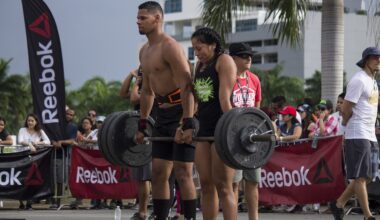Sprint Workouts to Improve Route Running for Wide Receivers
Sprint workouts designed for football wide receivers focus on enhancing speed, agility, and route running efficiency. These workouts emphasize short bursts of high-intensity sprints, complemented by adequate rest periods to allow recovery. Incorporating various exercises, such as plyometric drills and resistance sprints, can significantly boost both explosive power and acceleration. It is crucial to develop a structured program that combines these elements effectively. Start your training regimen with dynamic warm-ups to prepare the muscles. A common practice is to include drills that emphasize footwork, allowing the receiver to hone their quick changes of direction, as well as maintain optimal speed. Intervals can be included to increase endurance and speed over longer distances. Drills like the “3-cone drill” and “ladder drills” should be regularly executed to improve agility and foot speed. To track performance improvement, regularly measure 40-yard dash times and incorporate feedback loops for continuous adjustments. With dedication and persistence, these workouts can dramatically improve a wide receiver’s overall effectiveness during games. Consistent practice, paired with agility training, is essential to achieve the desired outcomes.
One effective sprint workout for wide receivers includes a series of short distance sprints. To execute this workout, set up five cones at ten yards apart in a straight line. Begin at the first cone and sprint to the second cone, then return to the first. Repeat this process, focusing on explosiveness from the start and quick changes in direction. Aim for a total of ten repetitions. After completing the series, take a adequate rest to ensure recovery before moving to the next drill. It’s advisable to have a coach or training partner provide feedback on your form, which is crucial for improvement. While performing sprints, pay attention to body positioning, and strive to keep your shoulders relaxed and your strides full. Strength training exercises are equally important, such as squats and lunges, to ensure overall muscle power. Incorporating both strength and sprint workouts will yield better results. Additionally, it is vital to maintain a healthy diet to support your training efforts. This can help optimize energy levels during workouts, leading to better performances on the field throughout the season.
Importance of Recovery in Sprint Training
Recovery is an essential component of any effective sprint training program, especially for wide receivers aiming to improve their route running. After sprint sessions, incorporating proper cooldown techniques is crucial. This typically includes light jogging or dynamic stretches to help muscles gradually return to their resting state. Adequate hydration during and after workouts also supports optimal recovery. Additionally, scheduling rest days between intense sprint workouts allows the muscles to repair and strengthen, preventing injuries. Incorporate foam rolling and stretching exercises into your routine as these can alleviate soreness and enhance flexibility. Nutrition plays a critical role in recovery as well; ensure a balanced diet that includes protein for muscle repair, carbohydrates for replenishing energy, and healthy fats for overall well-being. Most trainers recommend consuming a post-workout snack or shake to kickstart the recovery process. Furthermore, consider using contrast baths or ice baths to reduce muscle fatigue after intense workout sessions. Each of these recovery strategies significantly improves the effectiveness of sprint workouts and helps the athlete feel ready for upcoming training sessions and games.
Integrating agility drills into sprint workouts for wide receivers is vital for developing multi-directional speed. Making quick cuts and weaving through defenders forms the basis for successful route running. Ladder drills are an excellent method to enhance foot speed and coordination; position the ladder on the ground and execute a series of footwork patterns, aiming to complete them as quickly as possible without tripping over the rungs. Exercises like the “T-drill” improve the ability to change direction swiftly while sprinting. Start from a central point and sprint to each point in the letter T pattern, practicing deceleration techniques at all corners. These drills can be mixed with standard sprints for a comprehensive workout regimen. Consistent practice leads to adaptation, ensuring the body learns to perform under game-like conditions. Incorporating resistance training methods such as sled pulls can further develop strength for better speed. These quick explosiveness drills ensure that wide receivers can evade defenders effectively and run precise routes. Consistently adapting the training model to include cycling through sprint and agility drills is beneficial for long-term development.
Measuring Improvement in Performance
Monitoring progress in sprint workouts is essential for wide receivers dedicated to improving their skills. At the start of your training program, run timed sprints in standard drills such as the 40-yard dash to establish a baseline. Conduct these tests regularly, about every 4-6 weeks, to evaluate improvement. Recording results in a journal provides a visual representation of progress and helps to maintain motivation. Utilizing video analysis can also demonstrate tangible improvements in technique and form. Observing the recorded footage will allow identification of areas needing attention or adjustments. This reflective practice leads to greater strides in explosive speed, which can be gained through the incorporation of feedback. Additionally, setting specific, measurable goals will drive performance enhancement. Focus on maintaining an ideal sprinting technique while pushing personal benchmarks at each interval. These structured evaluations offer insight into your training effectiveness and inform necessary changes in the regimen to promote growth. As you observe your numbers improve, anticipate added confidence when facing competition in games, confirming the importance of structured and effective sprint workouts.
Wide receivers should consider incorporating different sprinting techniques as part of their development. The “flying 30” drill involves a 30-yard sprint at maximum speed, but with a 10-yard acceleration phase before reaching full pace. This exercise replicates in-game situations, allowing receivers to practice reaching top speed efficiently. Additionally, adding “resisted sprints” using parachutes or resistance bands can develop strength and speed. These resistance methods force the muscles to exert more effort, ultimately enhancing performance. Incorporating straight-line sprinting with lateral movements enhances coordination required for successful route running during gameplay. It is vital to balance distance training with short sprint intervals to prevent overtraining. High-intensity tempo runs can also be beneficial, ensuring endurance is built without sacrificing speed. Making use of rest periods during these workouts maximizes effort output during each interval. When combined with a well-rounded training regimen focusing on strength and agility, receivers will see substantial improvements over time. Continuous learning about the sport, alongside adapting workout plans based on personal performance metrics, results in ongoing enhancements in both speed and overall gameplay effectiveness.
Final Thoughts on Sprint Training for Receivers
In conclusion, sprint workouts for football wide receivers are critical for enhancing route running capabilities. A successful program requires a carefully planned approach that incorporates various components focused on speed, agility, and power. Consistent practice of well-structured sprint drills, including dynamic warm-ups and cooldown routines, ensures optimal performance. Incorporating agility drills alongside focused sprinting techniques prepares a receiver to respond to rapid in-game changes. Adequate rest and recovery methods further support muscle growth and speed retention, ensuring players can maintain peak performance throughout the season. Tracking progress and adapting training based on performance metrics greatly enhances development, allowing for strategic improvements. Finally, maintain a strong focus on nutrition to fuel workouts and recovery, optimizing energy levels. As receivers embrace these effective sprint training methodologies, they can achieve successful outcomes on the field. Emphasizing the importance of these workouts will ultimately lead to an improvement in both speed and decision-making abilities during games. This comprehensive approach equips wide receivers with the skills needed to excel and outmaneuver defenders in their pursuit of victory.
By integrating the principles outlined above into your training regimen, you are well on your way to becoming a more effective and explosive wide receiver. Embrace commitment and determination, and remember that training is not just about physical effort but also about mental resilience. Incorporate feedback from coaches and experienced players to continuously refine your techniques for route running. As you practice these workouts, aim to challenge yourself consistently, striving for personal bests while remaining aware of your body’s cues for recovery needs. Over time, building a strong foundation in speed and agility will lead to substantial skill enhancement on the field. The integration of varied sprinting methodologies will help you adapt quickly to in-game situations, positioning you as an invaluable asset to your team. Each workout should focus not only on increasing raw speed but also on improving response times and decision-making abilities. Ultimately, the journey of enhancing one’s sprinting capabilities is a continuous and rewarding process filled with opportunities for growth. Stay motivated, embrace learning, and always seek ways to elevate your performance in your quest as an exceptional wide receiver.


